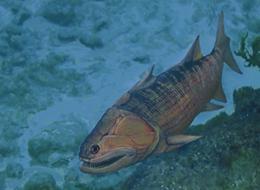
Artist`s rendering of what the bony fish may have looked like. [Museum Victoria, Australia]
Chinese scientists' discovery of an intact and ancient fish fossil might bring the search for modern vertebrate origins out of the Devonian age (416 to 359 million years ago) and into the preceding period.
In early May 2008, Zhu Min, a scientist with the Institute of Vertebrate Paleontology and Pale anthropology (IVPP) at the Chinese Academy of Sciences, along with his research team, found a bony fish fossil, which represents the oldest complete gnathostome, or jawed vertebrate, ever found in the world in Qujin, southwest China's Yunnan Province. The fossil was preserved in 418-million-year-old limestone.
Zhu and his team published an article about the finding in the British journal, Nature, on Thursday.
The fossil, which Zhu nicknamed "Dreamlike Ghost fish", or Guiyu oneiros, shows the skeletal anatomy of a small sarcopterygian, around 33 centimeters long.
It offers insights into the origin and early divergence of osteichthyes (bony fish plus tetrapods), as it exhibits a mosaic of gnathostome characters and fills in the morphological gap between osteichthyans and non-osteichthyan groups, Zhu said.
"Crucially, this piscine offshoot of our own distant past is both unusually intact and exceptionally old," Michael I. Coates from the Department of Organismal Biology and Anatomy at the University of Chicago wrote in a commentary accompanying Zhu's article in Nature.
The early split of the jawed vertebrate and the origins of bony fish play very important roles in the evolutionary history of vertebrates.
"By pushing a whole series of branching points in gnathostome evolution out of the Devonian and into the Silurian, the discovery of Guiyu also signals that a significant part of early vertebrate evolution is unknown," Coates said.
A summary of vertebrate diversity helps to understand the significance of Guiyu in the evolutionary history. Of the 51,000 or more living species of vertebrates, 99.9 percent have jaws: these are the gnathostomes. Gnathostomes include the bony Osteichthyes and the cartilaginous Chondrichthyes. Chondrichthyes (sharks, rays and chimaeras) account for only 2 percent of gnathostome species. Osteichthyes account for the other 98 percent.
European scientists began to carry out studies on bony fish in the Silurian period (443 to 416 million years ago) four decades ago, but were only able to find fragmentary fossils such as scales or fin-spines. Those fossils were not adequate to piece together the comprehensive features of the bony fish ancestors.
At the beginning of this century, European scientists intensified their efforts in finding bony fish fossils and Nature reported the discovery of two incomplete fish jaw fossils in 2007.
Still, there are many doubts and questions on the Silurian bony fish which remain unsolved. A complete ancient fish, recovered from the depositions which were 400 to 350 million years old, could help answer those questions, Zhu said.
The discovery of Guiyu further proved that the evolutionary history of osteichthyans (bony fish plus tetrapods) extends back to the Silurian period.
"On the whole, early fossils are thought to be unreliable as minimum-date markers of evolutionary branching events, because they are less complete or lack the full anatomical signature of the group to which they are assigned," said Coates.
"Guiyu might be an exception that proves the rule, for it provides a new and exceptionally reliable earliest fossil marker for a major split in vertebrate evolution," he said.
Coates predicted that Chinese scientists' discovery would provoke a rash of new fieldwork in the Silurian depositions and a fresh look at existing collections of pre-Devonian fossils. (From Xinhua)





